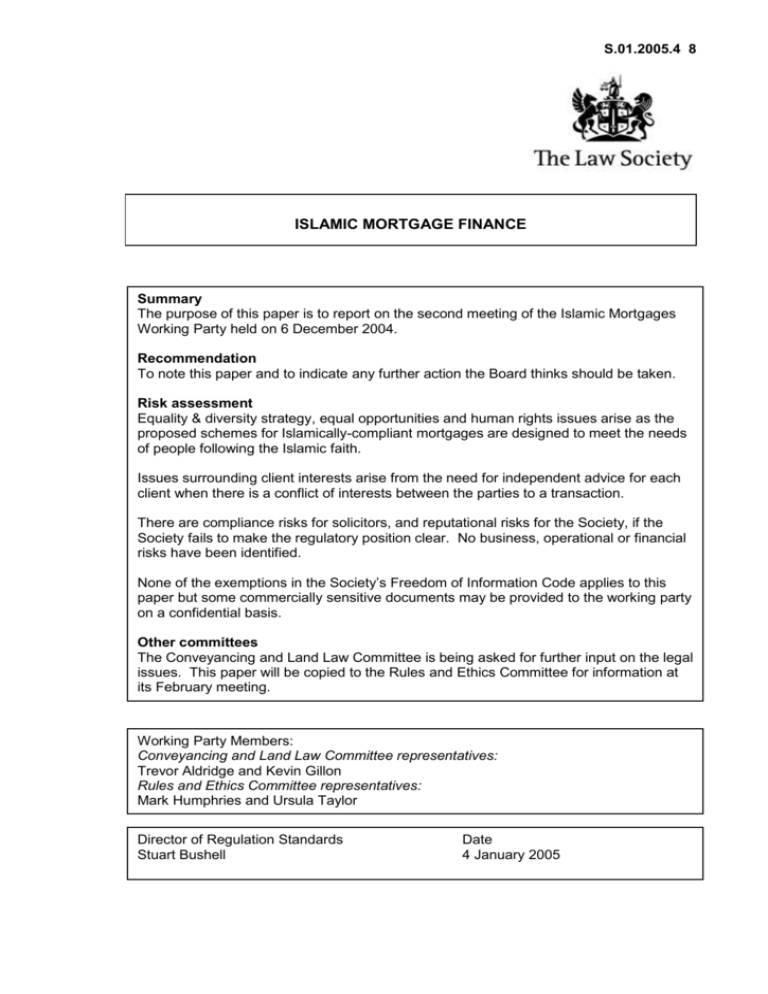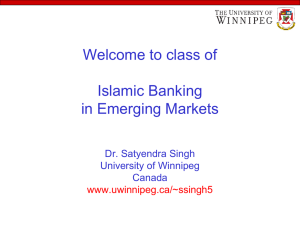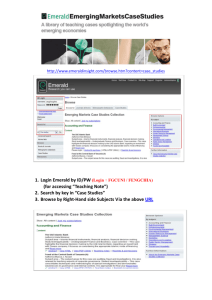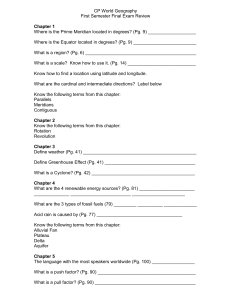Islamic mortgage finance - the Law Society's governance website
advertisement

S.01.2005.4 8 ISLAMIC MORTGAGE FINANCE Summary The purpose of this paper is to report on the second meeting of the Islamic Mortgages Working Party held on 6 December 2004. Recommendation To note this paper and to indicate any further action the Board thinks should be taken. Risk assessment Equality & diversity strategy, equal opportunities and human rights issues arise as the proposed schemes for Islamically-compliant mortgages are designed to meet the needs of people following the Islamic faith. Issues surrounding client interests arise from the need for independent advice for each client when there is a conflict of interests between the parties to a transaction. There are compliance risks for solicitors, and reputational risks for the Society, if the Society fails to make the regulatory position clear. No business, operational or financial risks have been identified. None of the exemptions in the Society’s Freedom of Information Code applies to this paper but some commercially sensitive documents may be provided to the working party on a confidential basis. Other committees The Conveyancing and Land Law Committee is being asked for further input on the legal issues. This paper will be copied to the Rules and Ethics Committee for information at its February meeting. Working Party Members: Conveyancing and Land Law Committee representatives: Trevor Aldridge and Kevin Gillon Rules and Ethics Committee representatives: Mark Humphries and Ursula Taylor Director of Regulation Standards Stuart Bushell Date 4 January 2005 S.01.2005.4 8 ISLAMIC MORTGAGE FINANCE Introduction 1. The Islamic Mortgages Working Party held its second meeting on 6 December 2004. The Working Party comprises two members of the Conveyancing and Land Law Committee (Trevor Aldridge, and Kevin Gillon standing in for Philip Freedman) and two members of the Rules and Ethics Committee (Mark Humphries and Ursula Taylor). 2. The Working Party was established to consider the nature of Islamic mortgages, to identify legal issues arising from the operation of Islamic mortgages, and to consider the inter-relationship between Islamic mortgage structures and practice rule 6 (avoiding conflicts of interest in conveyancing, property selling and mortgage related services). It reports to the Standards Board. 3. This paper reproduces, for ease of reference, the background to Islamic mortgage finance as set out in the paper considered by the Standards Board at its meeting on 11 October 2004. Background 4. The United Kingdom has a growing population of Muslims seeking to fund both commercial and residential property transactions through Islamicallycompliant borrowing facilities. Islamic law forbids the receipt and payment of interest. This makes conventional interest-based mortgage products unsuitable for Muslims. 5. Two basic methods of financing a house purchase to comply with Islamic law revolve around the financier acquiring the property. In method one, the financier buys the property and the customer enters into an agreement with the financier to buy the property for the same price over a specified period of time. In the meantime, the customer occupies the property under a lease from the financier and makes regular monthly payments towards the purchase price and rent. 6. In method two, the financier buys the property and immediately sells it on to the customer at a higher price determined by the number of years the purchase price is to be paid over. The financier has a first charge over the property and the customer makes regular monthly payments until the purchase price is paid. 7. A working group was established some time ago by the Bank of England to look into the barriers preventing Islamic mortgage products from being 2 S.01.2005.4 8 developed in the United Kingdom. The working group included representatives from lenders such as Barclays Bank Plc, the United Bank of Kuwait, HSBC and the Woolwich, and from community groups such as the Union of Muslim Organisations of the UK and Eire, the Muslim Council of Britain and the Institute of Islamic Banking and Insurance. 8. The issue has a high profile and the Inland Revenue, the Land Registry and the Council of Mortgage Lenders have been working with these organisations in an attempt to remove the barriers identified. For example, the double stamp duty land tax burden that arose on some Islamic schemes was removed in 2003. 9. A number of Islamically-compliant financing schemes are now being developed, particularly in relation to residential property transactions. There are, however, legal and regulatory problems that need to be addressed before lenders can offer competitive products comparable in cost and operation to conventional mortgages. 10. One of the barriers identified by the Bank of England Working Group relates to practice rule 6 and the apparent requirement for separate representation in Islamically-compliant mortgages. A non-Muslim buying residential property with the aid of a conventional mortgage will almost invariably have a solicitor who acts also for the lender, and thus pays only one set of legal fees. The cost issue does not often arise in commercial transactions where it is usual for buyers and lenders to be separately represented. 11. Rule 6 is based on the fundamental duty at common law that a solicitor must not act for two or more clients where there is a conflict, or a significant risk of conflict, between the interests of those clients. There are very few circumstances under rule 6(2) where a solicitor may act for both seller and buyer. Solicitors do, however, act for both lender and borrower under rule 6(3) on the basis of a limited retainer with the lender and, most importantly, subject to there being no conflict of interests. 12. In the case of an Islamically-compliant mortgage, the question arises whether there is an inherent risk of a conflict of interests by virtue of the lender becoming the intermediate seller or lessor of the property. The Office believes that the original Islamic finance schemes related to commercial transactions where the lender required separate representation. It is not known what approach is being taken by lenders and solicitors in relation to the Islamic finance schemes now being developed. Deliberations of the Working Party 13. The Working Party was able to consider documentation relating to both types of Islamic mortgage finance prior to its second meeting. It concluded that the 3 S.01.2005.4 8 considered view of the Conveyancing and Land Law Committee (C&LL) on the legal position is necessary to enable the Working Party to formulate its advice to the Standards Board on the ethical position. 14. There is clearly a divergence between established law and practice relating to conventional mortgages and the new Islamic “mortgages”. Although the double stamp duty land tax burden has been removed, it is interesting that the Land Registry treats the first purchase by the bank, and the subsequent purchase by the buyer/borrower, as separate transactions and charges separate fees. It does not treat the individual transfers as forming a composite transaction. However, the Land Registry may not always be able to identify Islamic mortgage transactions, and it is understood that such transactions are the cause of on-going concern within the Land Registry. 15. C&LL had previously expressed a series of doubts as to the legal validity of Islamic mortgages and put forward the view that the Law Commission should look at the matter. Legislation to clarify the position is preferable to waiting for litigation to resolve ensuing problems. 16. Although Islamic mortgage finance is a growing field and lenders will take their own advice, nothing has been tested in the courts yet. The solicitors who have drafted the current documentation are likely to have considered, and taken a view on, the reservations expressed by C&LL but concerns remain that these transactions may turn out to be ineffective. 17. If Islamic mortgage transactions are of doubtful validity at law, there is an inevitable conflict of interests in trying to act for both parties and a clear need for separate representation. Even representing one party alone presents problems. A lender’s position may well be worse than that of a borrower, although this probably would not be apparent until the lender sought to enforce the transaction. If a solicitor is asked to act in relation to a transaction of doubtful validity, he or she would be ill-advised to accept instructions. 18. The Working Party concluded that the matter should be referred back to C&LL for further consideration at its meeting on 26 January 2005. The paper to C&LL would pose specific problems on the legal aspects of Islamic mortgages and invite C&LL to identify any further legal issues. 19. Examples of the issues to be clarified and resolved are listed below: Is it correct at law to regard the separate transactions as together forming a mortgage? Is the chain of transactions valid at law? Has an effective legal charge been created? 4 S.01.2005.4 8 How should the transactions be registered and charged for by the Land Registry? What is the position in the event of the borrower’s insolvency? What is the position should married borrowers separate or divorce? What is the position should the bank need to enforce its security? Do any additional problems arise in connection with the borrower’s occupancy under a lease? Is the documentation suitable for buying “off-plan”, or for a partially-built development? Would members of C&LL feel able to act (for one or both parties), or would they regard themselves as being in a position of conflict? 20. C&LL may decide to seek advice through the Society’s legal advisers, and may also wish the issues to be raised again with the Law Commission. 21. In summary, the Working Party remains of the view that the doubts surrounding the legal validity of Islamic mortgage transactions leads to the conclusion that there would be difficulties in acting for both parties. However, until the legal issues are clarified and resolved, it is not in a position to make any formal recommendations on the ethical position. Recommendation To note this paper and to indicate any further action the Board thinks should be taken. Angela Doran 4 January 2005 5









